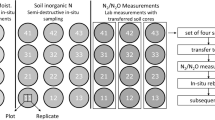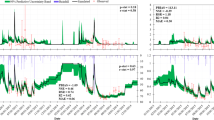Abstract
Agriculture currently accounts for 28% of national greenhouse gas emissions in Ireland. Nitrous oxide (N2O) emissions from agricultural soils account for 38% of this total. A 2-year study was conducted, using the chamber technique on a fertilized and grazed grassland to quantify the effect of fertilizer application rate, soil and meteorological variables on N2O emissions. Three N fertilizer regimes (0, 225 & 390 kg N ha−1) were imposed with three replicates of each treatment. Nitrogen fertilizer was applied as urea (46% N) in spring with calcium ammonium nitrate (CAN-26% N) applied in the summer (June–September). Rotational grazing was practiced using steers. Nitrous oxide emissions arising from the unfertilized plots (0 N) were consistently low. Emissions from the N-fertilized plots (225 & 390 kg N ha−1) were concentrated in relatively short periods (1–2 weeks) following fertilizer applications and grazing, with marked differences between treatments, relative patterns and magnitudes of emissions at different times of the year and between years. Variation in N2O emissions throughout both years was pronounced with mean coefficients of variation of 116% in year 1 and 101% in year 2. The study encompassed two climatologically contrasting years. As a result the N2O–N loss, as a percent of the N applied in the cooler and wetter 2002 (0.2–2.0%), were similar to those used for N-fertilized grasslands under the Intergovernmental Panel on Climate Change (IPCC) N2O emission inventory calculation methodology (1.25% ± 1). In contrast, the percentage losses in the warmer and drier 2003 (3.5–7.2%) were substantially higher.
Similar content being viewed by others
References
Aitchison J, Brown JAC (1957) The lognormal distribution with special reference to its uses in economics. Cambridge University Press, New York
Anger M, Hoffman C, Kühbauch W (2003) Nitrous oxide emissions from artificial urine patches applied to different N-fertilized swards and estimated annual N2O emissions for differently fertilized pastures in an upland location in Germany. Soil Use Manage 19:104–111
Bouwman AF (1996) Direct emissions of nitrous oxide from agricultural soils. Nutr Cycl Agroecosyst 46:53–70
Carran RA, Theobald PW, Evans JP (1995) Emission of nitrous oxide from some grazed pasture soils in New Zealand. Aust J Soil Res 33:341–352
Clayton H, Arah JRM, Smith KA (1994) Measurement of nitrous oxide emissions from fertilized grassland using closed chambers. J Geophys Res 99:16599–16607
Coulter BS (ed) (2001) Nutrient and trace element advice for grassland and tillage crops. Teagasc, Johnstown Castle Research Centre, Wexford
de Klein CAM, van Logtestijn RSP (1996) Denitrification in grassland soils in the Netherlands in relation to irrigation, N-application rate, soil water content and soil temperature. Soil Biol Biochem 28:231–237
Denmead OT, Leuning R, Jamie I, Griffith DWT (2000) Nitrous oxide emissions from grazed pastures: measurements at different scales. Chemosphere-Global Change Sci 2:301–312
Department of Agriculture, Food and Rural Development (DAFRD) (2000) Agri-Environmental Specifications for REPS 2000. DAFRD, Dublin
Department of the Environment, Heritage and Local Government (DEHLG) (2000) National Climate Change Strategy Ireland. DELG, Dublin
Diggle PJ, Heagarty P, Liang KY, Zeger SL (2003) Analysis of longitudinal data, 2nd edn. Oxford Statistical series 25, pp 114–125
Dobbie KE, McTaggart IP, Smith KA (1999) Nitrous oxide emissions from intensive agricultural systems: variations between crops and seasons, key driving variables, and mean emissions factors. J Geophys Res 104:21891–26899
Egginton GM, Smith KA (1986) Nitrous oxide emission from a grassland soil fertilized with slurry and calcium nitrate. J Soil Sci 37:59–67
Ellis S, Yamulki S, Dixon E, Harrison R, Jarvis SC (1998) Denitrification and N2O emissions from a UK pasture soil following the early spring application of cattle slurry and mineral fertiliser. Plant Soil 202:15–25
Estavillo JM, Rodriguez M, Domingo M, Munzo-Rueda A, Gonzalez-Murua C (1994) Denitirification losses from a natural grassland in the Basque country under organic and inorganic fertilization. Plant Soil 162:19–29
Folorunso OA, Rolston DE (1984) Spatial variability of field-measured denitrification gas fluxes. Soil Sci Soc Am J 48:1214–1219
Fowler D, Skiba U, Hargreaves KJ (1997) Emissions of nitrous oxide from grasslands. In: Jarvis SC, Pain BF (eds) Gaseous nitrogen emissions from Grasslands. CAB International, UK, pp 147–164
Gardiner, M.J. and Ryan, P (1964) Soils of County Wexford. National Soil Survey of Ireland. Soil Series Bulletin No: 1. An Foras Taluntais, 19 Sandymount Avenue, Dublin 4
Genstat Committee (2003) Genstat 6.2 Reference Manual. Lawes Agricultural Trust, Rothamsted Experimental Station, Harpenden, Hertfordshire, UK
Hénault C, Devis X, Pages S, Justes E, Reau R, Germin JC (1998) Nitrous oxide emission under different soil and management conditions. Biol Fert Soils 26:199–207
Intergovernmental Panel on Climate Change (IPCC) (1997) Revised 1996 IPCC Guidelines for National Greenhouse Gas Inventories. OECD, Paris
Jarvis SC, Barraclough D, Williams J, Rook AJ (1991) Patterns of denitrification loss from grazed grassland: effects of N fertilizer inputs at different sites. Plant Soil 131:77–88
Kelliher FM, Reisinger AR, Martin RJ, Harvey MJ, Price SJ, Sherlock RR (2002) Measuring nitrous oxide emission rates from grazed pasture using Fourier-transform infrared spectroscopy in the nocturnal boundary layer. Agric Forest Meteorol 111:29–38
McTaggart I, Clayton H, Smith K (1994) Nitrous oxide flux from fertilized grassland: strategies for reducing emissions. In: van Ham J, Janssen LHM, Swart RJ (eds) Non-CO2 greenhouse gases. Kluwer Academic Press, Dordrecht, pp 421–426
Mead R, Curnow RN, Hasted AM (1998) Statistical methods in agriculture and experimental biology, 2nd edn. Chapman and Hall, p 415
Merino MP, Estavillo JM, Pinto M, Rodríguez M, Duñabeitia MK, González-Murua C (2001) Nitrous oxide emissions from grassland in an intensive dairy farm in the Basque Country of Spain. Soil Use Manage 17:121–127
Mosier AR, Delgado JA, Cochran VL, Valentine DW, Parton WJ (1997) Impact of agriculture on soil consumption of atmospheric CH4 and a comparison of CH4 and N2O flux in subarctic, temperate and tropical grasslands. Nutr Cycl Agroecosyst 49:71–83
Smith KA (1997) The potential for feedback effects induced by global warming on nitrous oxide emissions by soils. Global Change Biol 3:327–388
Smith KA, Clayton H, McTaggart IP, Thomson PE, Arah JRM, Scott A (1995) The measurement of nitrous oxide emissions from soil using chambers. Philos Trans Roy Soc Lond 351:327–338
van Groeningen JW, Kuikman PJ, de Groot WJM, Velthof GL (2005) Nitrous oxide emission from urine-treated soil as influenced by urine composition and soil physical conditions. Soil Biol Biochem 37:463–473
Velthof GL, Oenema O (1995) Nitrous oxide fluxes from grassland in the Netherlands: II. effects of soil type, nitrogen fertilizer application and grazing. Europ J Soil Sci 46:541–549
Velthof GL, Oenema O (1997) Nitrous oxide emission from dairy farming systems in The Netherlands. Netherlands J Ag Sci 45:347–360
Velthof GL, Brader AB, Oenema O (1996a) Seasonal variations in nitrous oxide losses from managed grassland in The Netherlands. Plant Soil 181:263–274
Velthof GL, Jarvis SC, Stein A, Allen AG, Oenema O (1996b) Spatial variability of nitrous oxide fluxes in mown and grazed grasslands on a poorly drained clay soil. Soil Biol Biochem 28:1215–1225
Acknowledgements
This work was funded by Teagasc and the Irish Environmental Protection Agency under the Environmental Research Technological Development and Innovation (ERTDI) programme as part of the National Development Plan 2000–2006.
Author information
Authors and Affiliations
Corresponding author
Rights and permissions
About this article
Cite this article
Hyde, B., Hawkins, M., Fanning, A. et al. Nitrous Oxide Emissions from a Fertilized and Grazed Grassland in the South East of Ireland. Nutr Cycl Agroecosyst 75, 187–200 (2006). https://doi.org/10.1007/s10705-006-9026-x
Received:
Accepted:
Published:
Issue Date:
DOI: https://doi.org/10.1007/s10705-006-9026-x




